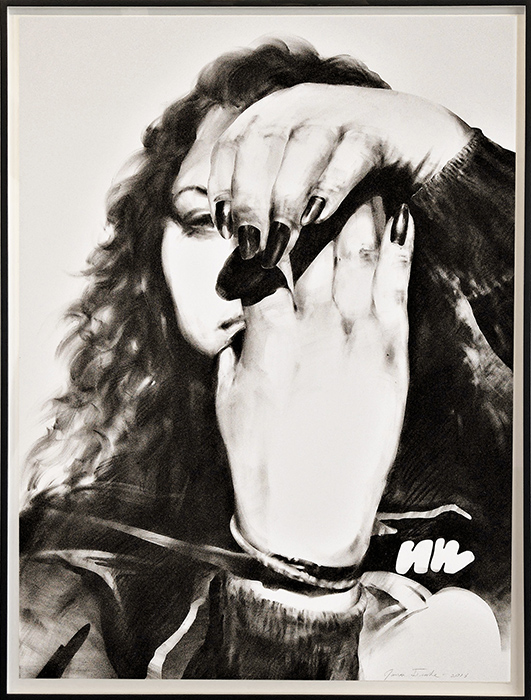
An exhibition of work by James Drake will open at Charlotte Jackson Fine Art on August 30 and extend to September 28, with an opening reception on Friday, August 30th, from 5-7 p.m. at the gallery, which is located at 554 S. Guadalupe in the Railyard Art District. A Gallery Talk including readings and discussion with James Drake and award-winning poet, Jimmy Santiago Baca, moderated by David Chickey, will take place on Saturday, August 31st at 3 p.m. Book Signing will take place on both August 30th and 31st.
In stark black and white, a woman stands with one hand folded purposely over another. Another woman, face dappled in shadow, looks upward with longing at something we, as viewers, cannot see. A flock of ghostly black sparrows are ringed by an elaborate, old-fashioned frame design. Elsewhere hands flex and flare into a gesture of wings.
Photographs. Drawings. Video. Text. James Drake’s Tongue-Cut Sparrows is a massive undertaking, bringing together an astonishing range of arts media, created and developed over the course of 30 years (and still ongoing). As with so much of Drake’s work, this series has its origins in the borderlands of El Paso, where he lived and worked for decades. The project was sparked in 1994 by curiosity over witnessing a group of people (mostly women) gathered outside of the El Paso County Jail, moving, gesturing, and signing up toward the prison. He asked a friend about what was happening and discovered that these were family, friends, and lovers of prisoners, using an invented language of signs and gestures to communicate to their loved ones over distance, and without having to submit to the timetables, strictures, limitations, and scrutiny of official prison visits.
He was able to negotiate an introduction to the group, and slowly gain their trust. Drake has an amazing ability (as witnessed in other of his ongoing projects) to connect and enter into the cultural context of another, to investigate and find common ground. As an artist, he found his subjects were often more willing to let him in and share with him – curious about his work and perspective. Over the course of two years, Drake met with members of this community, asking questions, learning about the language, taking photos and video, and eventually collaborating with them. While the usual communications that these women make are about ordinary sorts of subjects, (How are the kids? When is my lawyer coming? I miss you. I love you.), Drake asked them if they’d be willing to translate and sign texts by famous authors. Drake brought in many favorites, from Shakespeare, Lorca and Machado to contemporary authors like Cormac McCarthy and Jimmy Santiago Baca. The subjects chose works that resonated with them, often in Spanish and English versions. Drake captured some of these gestural performances on video.
The title of the project originally comes from a Japanese folktale in which a sparrow is rescued and befriended by an older couple. A jealous woman cuts the tongue of the sparrow, leaving it injured, unable to speak, and forced back into the woodland. The old man eventually finds his sparrow friend along with a whole community of magical sparrows, who are so grateful for his intervention that they offer him a reward for his kindness.
There is a Hokusai painting of the folktale, Shita-kiri Suzume (literally translated to Tongue-Cut Sparrow), showing an open-mouthed sparrow flying above a pair of sheers. Almost invisible is the tiny brown crescent of the sparrow’s tongue, floating between the two. To be “tongue-cut” is a violent and shocking image, a powerful metaphor for disenfranchisement and the prejudices and economics that so often silence individuals and communities. The ingenious and creative language developed by the group Drake encountered (and echoed by the existence of other groups all over the world, who sign in their own invented languages to loved ones in prison) is a remarkable response to silencing.
Through the years exhibitions of works from Tongue-Cut Sparrows have occurred all over the world, from the Venice Biennale in 2009 to the Albright Knox in 2011 and galleries in New York, Texas, and elsewhere. Following this exhibition at Charlotte Jackson Fine Art in Santa Fe, there are multiple more exhibitions planned, including for SITE Santa Fe in 2026 and a collaborative performance piece at Carnegie Hall in October of this year.
Drake’s unique and diverse assemblage of art (artifacts?), in many media, drops us into the middle of a dialogue, a story. We are in the position of the outsider – like a prison guard at the El Paso jail, or a random passerby on the sidewalk – witnessing a language for which we don’t have the knowledge of grammar or syntax, let alone vocabulary. With Drake’s work we are presented with a symbolic and metaphoric expression, articulating itself in multiple forms, numerous media, or perhaps more accurately – in multiple gestures. Painting, video, photography, poetry. Each is a part of a whole message: a love letter, a documentary, an essay of social anthropology, a novel. We are invited into this unknown, yet deeply human and familiar world, to translate for ourselves a deep and multifaceted story.
– Michaela Kahn, Ph.D.
